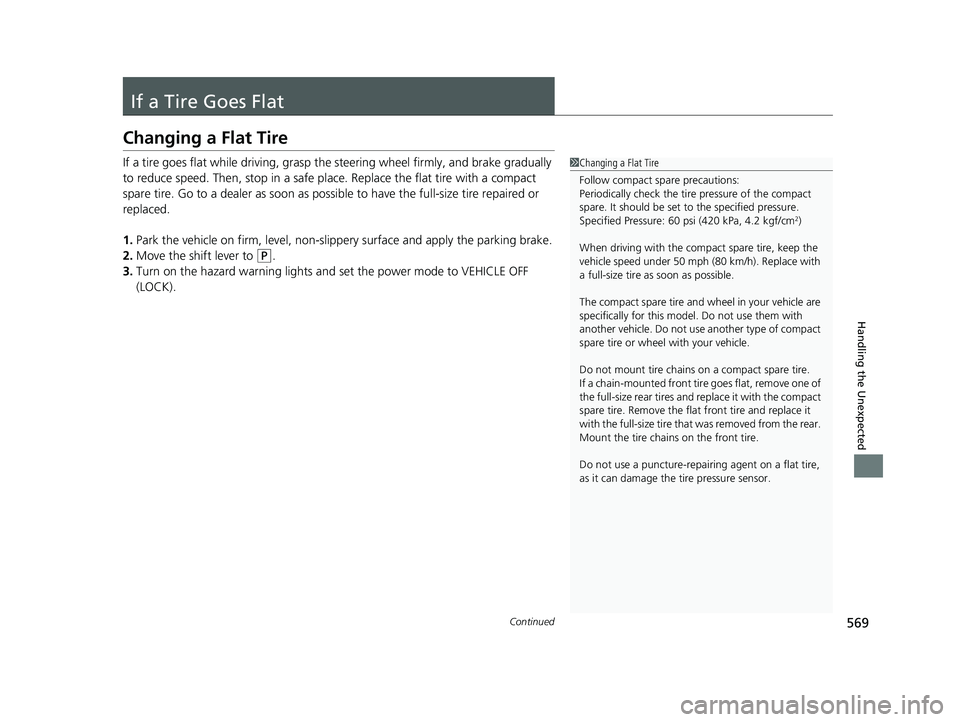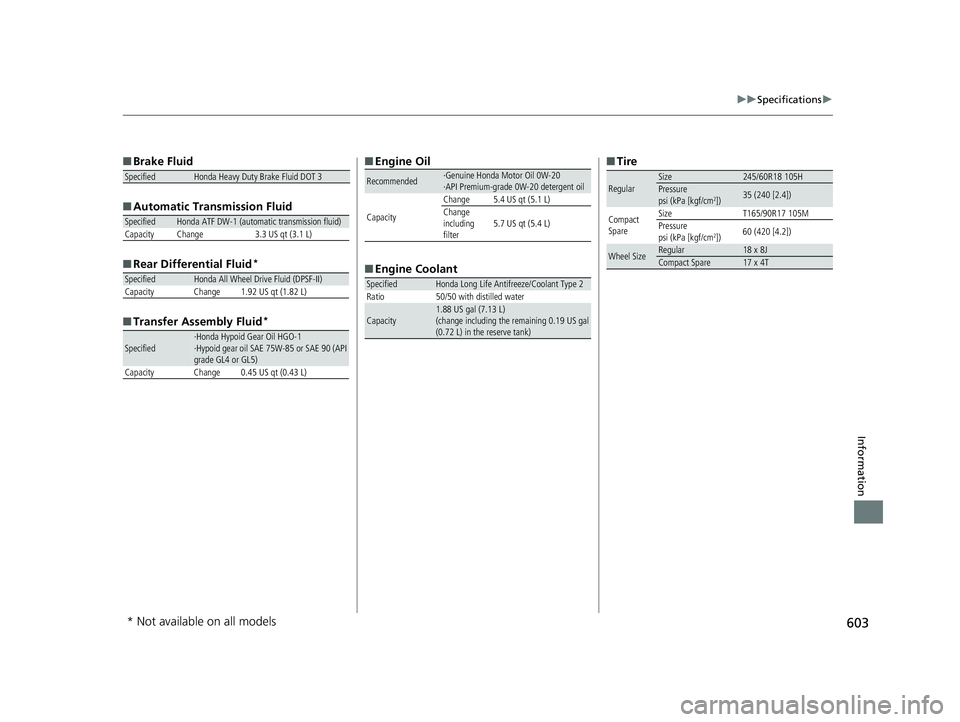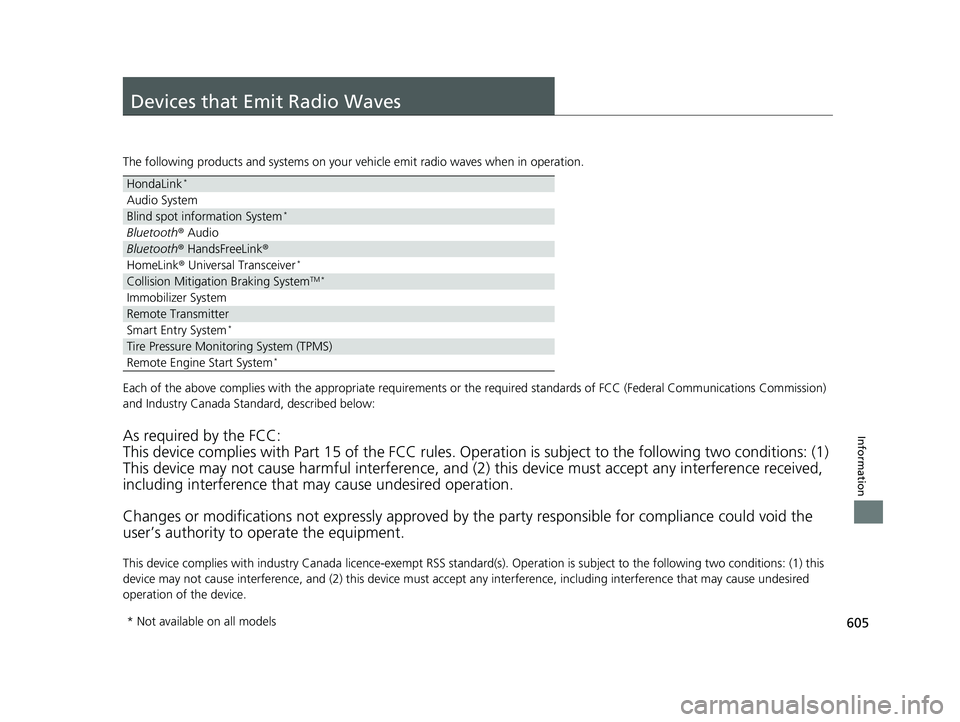2019 HONDA RIDGELINE tire pressure
[x] Cancel search: tire pressurePage 555 of 624

553
uuChecking and Maintaining Tires uTire and Wheel Replacement
Maintenance
Tire and Wheel Replacement
Replace your tires with radials of the sa me size, load range, speed rating, and
maximum cold tire pressure rating (as shown on the tire’s sidewall). Using tires of a
different size or construction can cause the Vehicle Stability Assist ® (VSA®), hill start
assist, and the all-wheel drive (AWD)
* systems as well as ABS to work incorrectly.
It is best to replace all four tires at the same time. If that isn’t possible, replace the
front or rear tires in pairs.
If you replace a wheel, only use TPMS spec ified wheels approved for your vehicle.
Make sure that the wheel’s specificati ons match those of the original wheels.
1Tire and Wheel Replacement
3WARNING
Installing improper tires on your vehicle can
affect handling and stability. This can cause
a crash in which you can be seriously hurt or
killed.
Always use the size and type of tires
recommended in this owner’s manual.
* Not available on all models
Page 569 of 624

567
Handling the Unexpected
This chapter explains how to handle unexpected troubles.
ToolsTypes of Tools .................................. 568
If a Tire Goes Flat Changing a Flat Tire ......................... 569
Engine Does Not Start Checking the Engine ........................ 578
If the Smart Entry Remote Battery is Weak .......................................... 579
Emergency Engine Stop ................... 580
Jump Starting .................................... 581
Shift Lever Does Not Move .............. 584Overheating
How to Handle Overheating............. 585
Indicator, Coming On/Blinking
If the Low Oil Pressure Indicator Comes On ............................................. 587
If the Charging System Indicator Comes
On ................................................. 587
If the Malfunction Indicator Lamp Comes On or Blinks ................................... 588
If the Brake System Indicator (Red) Comes On .................................................... 589
If the Electric Power Steering (EPS) System
Indicator Comes On ........................... 589 If the Low Tire Pressure/Tire Pressure
Monitoring System (TPMS) Indicator Comes
On or Blinks........................................ 590
Fuses
Fuse Locations ................................. 591
Inspecting and Changing Fuses ........ 595
Emergency Towing ........................... 596
When You Cannot Unlock the Fuel Fill Door ................................................. 597
Refueling
Refueling From a Portable Fuel Container ................................... 598
Page 571 of 624

569Continued
Handling the Unexpected
If a Tire Goes Flat
Changing a Flat Tire
If a tire goes flat while driving, grasp the steering wheel firmly, and brake gradually
to reduce speed. Then, stop in a safe plac e. Replace the flat tire with a compact
spare tire. Go to a dealer as soon as possib le to have the full-size tire repaired or
replaced.
1. Park the vehicle on firm, level, non-slip pery surface and apply the parking brake.
2. Move the shift lever to
(P.
3. Turn on the hazard warning lights an d set the power mode to VEHICLE OFF
(LOCK).
1 Changing a Flat Tire
Follow compact spare precautions:
Periodically check the tire pressure of the compact
spare. It should be set to the specified pressure.
Specified Pressure: 60 psi (420 kPa, 4.2 kgf/cm
2)
When driving with the compact spare tire, keep the
vehicle speed under 50 mph (80 km/h). Replace with
a full-size tire as soon as possible.
The compact spare tire and wheel in your vehicle are
specifically for this model. Do not use them with
another vehicle. Do not us e another type of compact
spare tire or wheel with your vehicle.
Do not mount tire chains on a compact spare tire.
If a chain-mounted front tire goes flat, remove one of
the full-size rear tires and replace it with the compact
spare tire. Remove the flat front tire and replace it
with the full-size tire that was removed from the rear.
Mount the tire chains on the front tire.
Do not use a puncture-repairi ng agent on a flat tire,
as it can damage the tire pressure sensor.
Page 579 of 624

577
uuIf a Tire Goes Flat uChanging a Flat Tire
Handling the Unexpected
If you replace a flat tire with the spare tire, the low tire pressure/TPMS indicator
comes on while you are driving. After dr iving for a few miles (kilometers), the
indicator will start blinking for a short time and then stay on. Tire Pressure
Monitor Problem appears on the multi-information display, but this is normal.
If you replace the tire with a specified regular tire, the warning message on the
multi-information display and the low tire pressure/TPMS indicator will go off after
a few miles (kilometers).
■TPMS with Tire Fill Assist and the Compact Spare Tire1 TPMS with Tire Fill Assist and the Compact Spare Tire
The system cannot monitor th e pressure of the spare
tire. Manually check the spare tire pressure to be sure
that it is correct.
Use the TPMS specific wheels. Each is equipped with
a tire pressure sensor mount ed inside the tire behind
the valve stem.
Page 592 of 624

590
uuIndicator, Coming On/Blinking uIf the Low Tire Pressure/Tire Pressure Monitoring System (TPMS) Indicator Comes On or Blinks
Handling the Unexpected
If the Low Tire Pressure/Tire Pressure Monitoring
System (TPMS) Indicato r Comes On or Blinks
■Reasons for the indicator to come on or blink
The pressure of one or more tires is significantly low, or TPMS with Tire
Fill Assist has not been calibrated. If there is a problem with TPMS with
Tire Fill Assist or the compact spare tire is installed, the indicator blinks
for about one minute, and then stays on.
■What to do when the indicator comes on
Drive carefully and avoid abrupt cornering and hard braking.
Stop your vehicle in a safe place. Ch eck the tire pressure and adjust the
pressure to the specified level. The sp ecified tire pressure is on a label on
the driver side doorjamb.
■What to do when the indicator blinks, then remains on
Have the tire inspected by a dealer as soon as possible. If the compact
spare tire causes the indicator to blink, change the tire to a full-size tire.
The indicator goes off after driv ing for a few miles (kilometers).
1If the Low Tire Pressure/Tire Pressure Monitoring System (TPMS)
Indicator Comes On or Blinks
NOTICE
Driving on an extremely unde rinflated tire can cause
it to overheat. An overheated tire can fail. Always
inflate your tires to the prescribed level.
TPMS with Tire Fill Assist provides visual and audible
assistance during tire pre ssure adjustment. With the
power mode in ON, while y ou adjust tire pressure up
or down, the system alerts you as follows:
Below recommended pressure: The beeper
sounds and exterior lights flash once every five
seconds.
At recommended pressure: The beeper sounds
and exterior lights flash rapidly for five seconds.
Above recommended pressure: The beeper
sounds and lights flash twice every three seconds.
Page 605 of 624

603
uuSpecifications u
Information
■Brake Fluid
■ Automatic Transmission Fluid
■ Rear Differential Fluid
*
■Transfer Assembly Fluid*
SpecifiedHonda Heavy Duty Brake Fluid DOT 3
SpecifiedHonda ATF DW-1 (automatic transmission fluid)
Capacity Change 3.3 US qt (3.1 L)
SpecifiedHonda All Wheel Drive Fluid (DPSF-II)
Capacity Change 1.92 US qt (1.82 L)
Specified·Honda Hypoid Gear Oil HGO-1
·Hypoid gear oil SAE 75W-85 or SAE 90 (API
grade GL4 or GL5)
Capacity Change 0.45 US qt (0.43 L)
■ Engine Oil
■ Engine Coolant
Recommended·Genuine Honda Motor Oil 0W-20
·API Premium-grade 0W-20 detergent oil
Capacity Change 5.4 US qt (5.1 L)
Change
including
filter
5.7 US qt (5.4 L)
SpecifiedHonda Long Life Antifreeze/Coolant Type 2
Ratio 50/50 with distilled water
Capacity1.88 US gal (7.13 L)
(change including the remaining 0.19 US gal
(0.72 L) in the reserve tank)
■ Tire
RegularSize245/60R18 105HPressure
psi (kPa [kgf/cm2])35 (240 [2.4])
Compact
Spare Size
T165/90R17 105M
Pressure
psi (kPa [kgf/cm
2]) 60 (420 [4.2])
Wheel SizeRegular18 x 8JCompact Spare17 x 4T
* Not available on all models
Page 607 of 624

605
Information
Devices that Emit Radio Waves
The following products and systems on your vehicle emit radio waves when in operation.
Each of the above complies with the appropriate requirements or the required standards of FCC (Federal Communications Commissio n)
and Industry Canada Standard, described below:
As required by the FCC:
This device complies with Part 15 of the FCC rules. Operation is subject to the following two conditions: (1)
This device may not cause harmful interference, and (2) this device must accept any interference received,
including interference that may cause undesired operation.
Changes or modifications not expres sly approved by the party responsible for compliance could void the
user’s authority to operate the equipment.
This device complies with indus try Canada licence-exempt RSS standard(s). Operation is subject to the following two conditions: (1) this
device may not cause interference, and (2) this device must ac cept any interference, including interference that may cause unde sired
operation of the device.
HondaLink*
Audio System
Blind spot information System*
Bluetooth ® Audio
Bluetooth® HandsFreeLink ®
HomeLink® Universal Transceiver*
Collision Mitigati on Braking SystemTM *
Immobilizer System
Remote Transmitter
Smart Entry System*
Tire Pressure Monitoring System (TPMS)
Remote Engine Start System*
* Not available on all models
Page 617 of 624

615
Index
Collision Mitigation Braking SystemTM
(CMBSTM) ................................................. 494
Indicator ............................................. 88, 89
Compact Spare Tire .......................... 569, 603
Console Compartment ............................. 174
Controls .................................................... 109
Conversation Mirror ................................ 179
Coolant (Engine) ...................................... 535
Adding to the Radiator ........................... 536
Adding to the Reserve Tank .................... 535
Overheating ............................................ 585
Creeping (Automatic Transmission) ........ 441
Cross Traffic Monitor ............................... 508
Cruise Control .......................................... 447
Indicator ................................................... 82
Cup Holders .............................................. 175
Customer Service Information ................ 612
Customized Features ............................... 318
D
Daytime Running Lights .......................... 150
Dead Battery ............................................ 581
Defaulting All the Settings ...................... 348
Defogger/Heated Door Mirror ................ 156
Defrosting the Windshield and Windows ......................................... 189, 198
Devices that Emit Radio Waves ............... 605
Dimming Headlights .............................................. 146
Rearview Mirror ...................................... 161 Dipstick (Engine Oil)
................................. 531
Directional Signals (Turn Signal) ............. 145
Display Button .......................................... 226
Door Mirrors ............................................. 162
Doors ......................................................... 111
Auto Door Locking .................................. 124
Auto Door Unlocking ............................... 124
Door Open Message ............................ 34, 91
Keys ........................................................ 111
Locking/Unlocking the Doors from the Inside ................................ 14, 121
Locking/Unlocking the Doors from the Outside ................................... 114
Lockout Prevention System ...................... 120
DOT Tire Quality Grading ........................ 550
Driving ....................................................... 411
Adaptive Cruise Control (ACC) ................ 457
Automatic Transmission ........................... 441
Braking .................................................... 490
Cruise Control ......................................... 447
Off-Highway Driving Guidelines ............... 432
Starting the Engine .................................. 434
Driving Guidelines for Your Utility Vehicle ..................................................... 440
Driving Position Memory System ............. 158
Dust and Pollen Filter ............................... 558
E
ECON Button............................................. 444
ECON Mode Indicator ................................ 87 Electric Power Steering (EPS) System
Indicator............................................ 80, 589
Electronic Stability Control (ESC) ............. 478
Emergency ................................................ 596
Emergency Trunk Opener ........................ 132
Emissions Testing (Readiness Codes) ....... 607
Engine ....................................................... 604
Coolant ................................................... 535
Jump Starting .......................................... 581
Oil ........................................................... 530
Remote Engine Start................................ 436
Starting ................................................... 434
Engine Compartment Cover .................... 529
Engine Coolant ......................................... 535
Adding to the Radiator ............................ 536
Adding to the Reserve Tank..................... 535
Overheating ............................................ 585
Temperature Gauge ................................ 103
Engine Oil ................................................. 530
Adding .................................................... 532
Checking................................................. 531
Displaying Oil Life .................................... 523
Low Oil Pressure Indicator ................. 75, 587
Recommended Engine Oil ....................... 530
ENGINE START/STOP Button .................... 142
EPS (Electric Power Steering) System ............................................... 80, 589
Exhaust Gas Hazard
(Carbon Monoxide) .................................. 70
Exterior Care (Cleaning) ........................... 561
Exterior Mirrors ........................................ 162